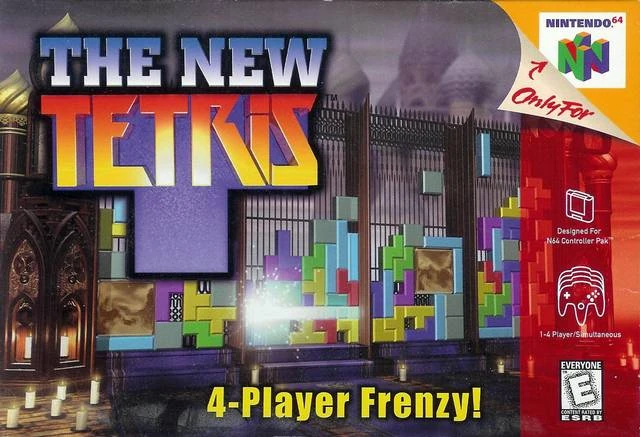Developer: H2O Entertainment Publisher: Nintendo
Released: July 31, 1999 Rated: E 8/10
Obviously, Tetris as a gameplay concept is something that needs no introduction, being the quintessential reference point of successful puzzle gameplay since its debut in the mid-1980s. But with three options for Tetris on the Nintendo 64 (two in the west and one Japan-exclusive), there’s obviously some investigation to be done as to the different options available, and why The New Tetris is deserving of the crown as the finest iteration of the classic formula on the console – and my personal favorite release of the game ever, with or without the nostalgia factor included.


From a gameplay standpoint, there are no grand, sweeping alterations to the formula made in any feature or game mode. The omnipresence of key mechanics added into The New Tetris mean that they can be completely ignored by the average player unless performed by accident, but in a vacuum from game to game, there is nothing that says you must use the features made available to rack up more points. If a leisurely game of Tetris is all you’re after, you don’t need to do anything different than if you were playing your GameBoy. The introduced mechanics include gold and silver blocks, which form when four individual tetrominoes are placed to form a perfect 4×4 square, and carry a multiplier for clearing them away. There are also spin moves and wall kicks, which are performed by rotating pieces into place as they land to fill a line you otherwise couldn’t. This rewards players by breaking up existing pieces into individual 1×1 blocks, which drop down wherever possible and may combo you into some more lines and breathing room. Both of these score mechanics have survived in subsequent releases in some way, as has the ability to hold a piece and swap it out later, and to see up to three upcoming pieces, all making for the addition of key features that still fit the spirit of the original gameplay and have been embraced by the majority of players.

This is all certainly well and good for Tetris as a general franchise, clearly owing a lot to this particular title and the work done at H2O for continuing to keep the ideas moving forward, even when it may have already been perfected. But where The New Tetris is still worth going back to is in its presentation, which has been a true standout of atmosphere and concept nearly on par with more recent years’ Tetris Effect. The “travel the world” concept that likely owes a lot of its inspiration to Tetris’s own heritage as “The Soviet Mind Game,” offers some really lovely visuals as players strive to complete Wonders – literal wonders of the world, though not one particular set of them, including The Great Sphinx, Stonehenge, and, of course, The Kremlin, which is completed when a profile accrues an astonishing 500,000 lines. It’s good, then that The New Tetris, and its early iterations of an achievement or trophy system, is an experience cultivated specifically for players to get lost in, as the calming visuals and world-music inspired soundtrack composed by the brilliant Neil Voss make for a game as addictive and yet as calming as ever.
Continuing Legacy
The New Tetris was the genesis of many important gameplay innovations that enthusiasts have held onto and utilized to boost scores, but I truly believe that the combination puzzle, rhythm, and sensory deprivation chamber simulator that is Tetris Effect is a division of the Tetris formula that owes a lot to Neil Voss and H2O’s presentation for this version of the game.
Additional Information
Saves: Cartridge, Controller Pak
Compatible With: None
Players: 1-4
Print Guides: None
Aggregate Critical Reception (GameRankings): 82.00%, based on 7 reviews
Other Releases: EU, October 15, 1999
My Streams
Commercials and Print Ads

